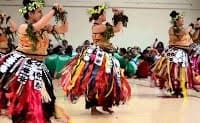Tuvalu, formerly Ellice Islands, country in the west-central Pacific Ocean. It is composed of nine small coral islands scattered in a chain lying approximately northwest to southeast over a distance of some 420 miles (676 km).
The de facto capital is the village of Vaiaku, where most government offices are located. It is on Fongafale islet, a constituent part of Funafuti Atoll. Together with what is now Kiribati (formerly the Gilbert Islands), Tuvalu formed the British Gilbert and Ellice Islands Colony before separately gaining its independence in 1978.
Culture
The Tuvaluan lifestyle has been Westernized to an extent, but Western-style amenities are few. Only Funafuti has a regular electricity supply; the government publishes a brief news sheet, but there is no newspaper; a few motion pictures are shown; satellite television service is available only by subscription; and there is only a single radio station.
Most Tuvaluans live in villages of a few hundred people, tend their gardens, and fish from handcrafted canoes. Traditional music and dancing still enjoy a strong following, along with Western forms. Volleyball, football (soccer), and cricket are popular. Tuvaluan life, despite modernization, still rests on a firm traditional base that emphasizes the importance of community consensus and identity.
Ethnic composition
The Tuvaluans are Polynesian, and their language, Tuvaluan, is closely related to Samoan. Nui, however, was heavily settled in prehistoric times by Micronesians from the Gilbert Islands (now Kiribati). English is taught in the schools and widely used. The vast majority of the population belongs to the Church of Tuvalu (the former Ellice Islands Protestant Church).

Fashion
The Art of Tuvalu has traditionally been expressed in the design of clothing and traditional handicrafts such as the decoration of mats and fans. Tuvaluan clothing was traditionally made from Fala leaves.
The material culture of Tuvalu uses traditional design elements in artifacts used in everyday life such as the design of canoes and fish hooks made from traditional materials. The design of women’s skirts (titi) and tops (teuga saka), that are used in performances of the traditional dance songs of Tuvalu, represents contemporary Tuvaluan art and design.
The collection of the Museum of New Zealand holds Tuvaluan artifacts and handicraft, including a man’s jacket and a Mother Hubbard dress made from pandanus leaves that were made following the impact of Christian missionaries who demanded that the women of Tuvalu adopt more conservative clothing as compared to traditional Tuvaluan clothing.
Art and Decoration
- Graphic Arts. The only production of graphic artistry is the decoration of mats, dancing skirts, and fans with dyed fibers.

Graphic art
- Performance Arts.The major artistic traditions are performance-oriented. Action songs known as faatele reign supreme. Seated vocalists sing the repeated verses of a song faster and faster until they reach a climax and stop abruptly, while standing dancers act out the lyrics.
Faatele may involve competition between different sides, be an adjunct to other festivities, or be an end in themselves, and may be composed and choreographed by anyone with the inspiration to do so. Tuvaluans also enjoy other kinds of musical activity, including hymn singing, Western-style dancing, and pop music. The verbal arts are confined to oratorical performances, which are the exclusive domain of older men.

Traditional Funafuti attire

Traditional Clothing
In some Polynesian islands can show how much pizzazz and artistry in the dance itself. The people who make dance costumes are artists in fibres and textures. The designs a mixture of natural materials like leaves or seeds and imported colourful things like beads or cloth.
Some costume designer may even gather materials from their local environment, choosing plants for appearance. Things like flowers of shells may be chosen from a specific place for symbolic value.
Them they might mix these natural materials with imported materials such as Velcro fastening, plastic, raffia or synthetic beads. Colours of costumes may indicate current status, or membership of a particular group such as a village, school or church, or nationality, but choice can also be the personal preference of the maker.
Handicrafts
The women use cowrie and other shells in Traditional handicrafts decoration of mats, fans and wall hangings that dyed fibres are woven in classic design pieces. One of the most arts practiced by women is crochet. Crocheting is an important aspect of Tuvalu culture and is often worn when attending church, dances and often given as a gift during special occasions.
Traditional headbands made out of pandanus, like ones worn for the launching of a chief would a particular design and the task of making the headband would be given to a particular person e.g. The daughter of the chief. A classic floral garland worn by a young women or headband for a woman would also have a specific design using gardenias, guettarda speciosa and frangipanis.

A Te titi Tao is a traditional skirt
A Te titi Tao is a traditional skirt put on another skirt and tops, wristbands, headbands and armbands are still used in performances of traditional Tuvaluan dance music e.g. The fatele. The dance ‘fatele’ (in its modern form) is performed at committed events and to celebrate leaders and other outstanding individuals.
Modern dancing skirts and tops may still have pandanus leaves in the design, as well as manufactured or natural cloth that is decorated with bold geometric motifs and bright bold colours.
The men of Tuvalu also join in in the dances and performances of the traditional music in the costumes that show classic Tuvaluan style that are made from pandanus leaves and manufactured or natural cloth that have bright bold colours. Most marriage ceremonies are usually done with the man and the lady wearing traditional costumes.
Article by- Sneha Savla






